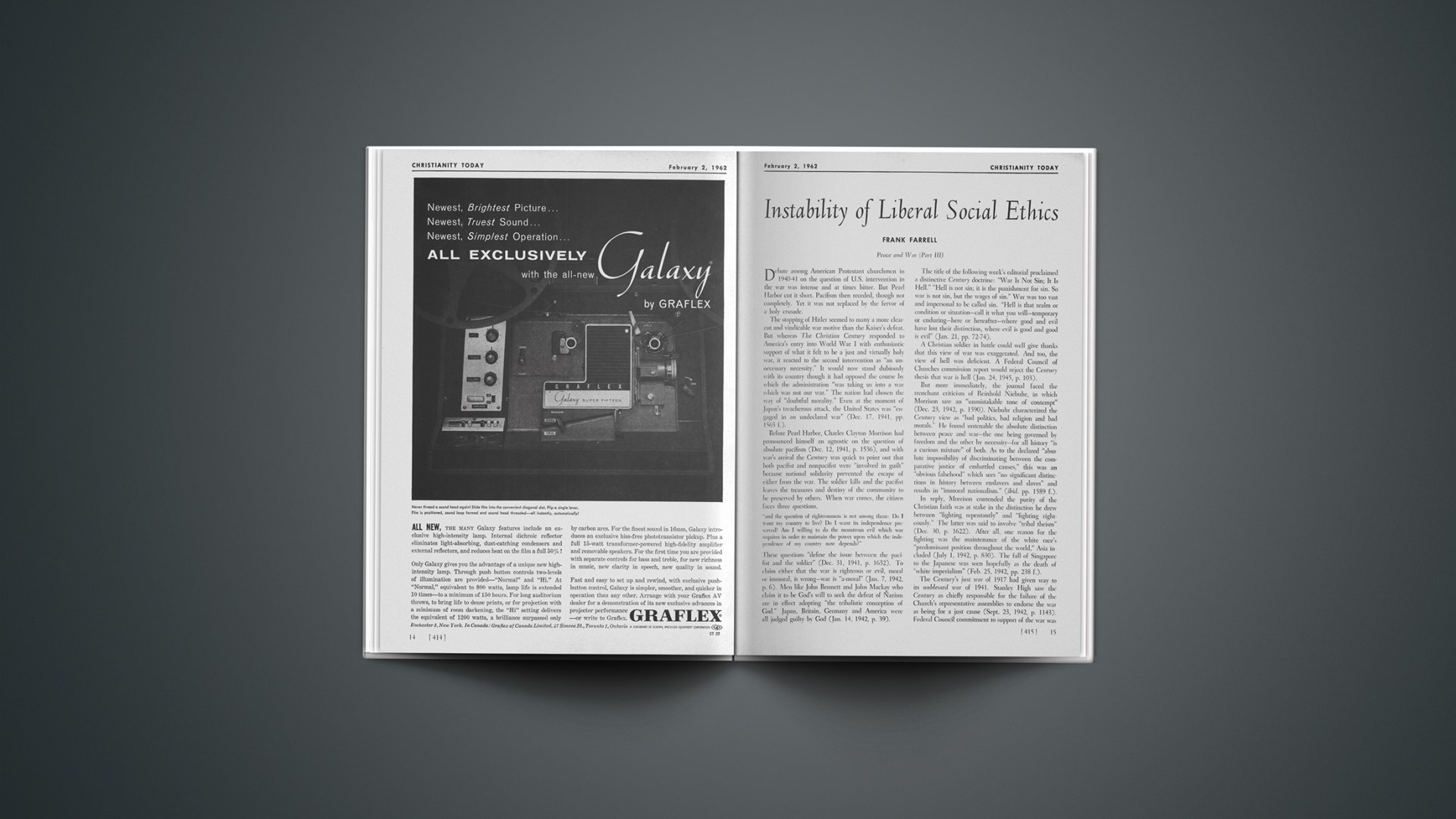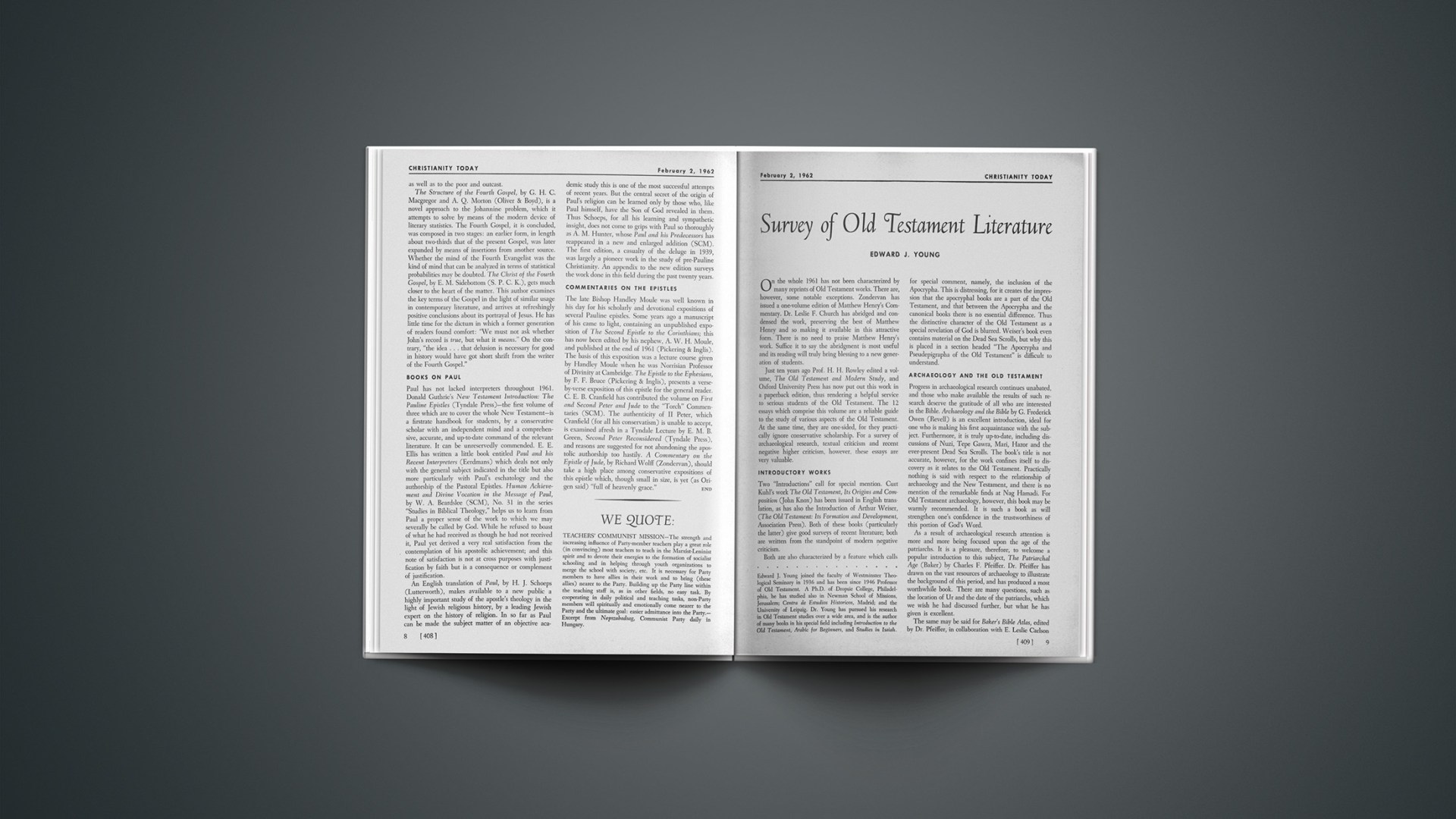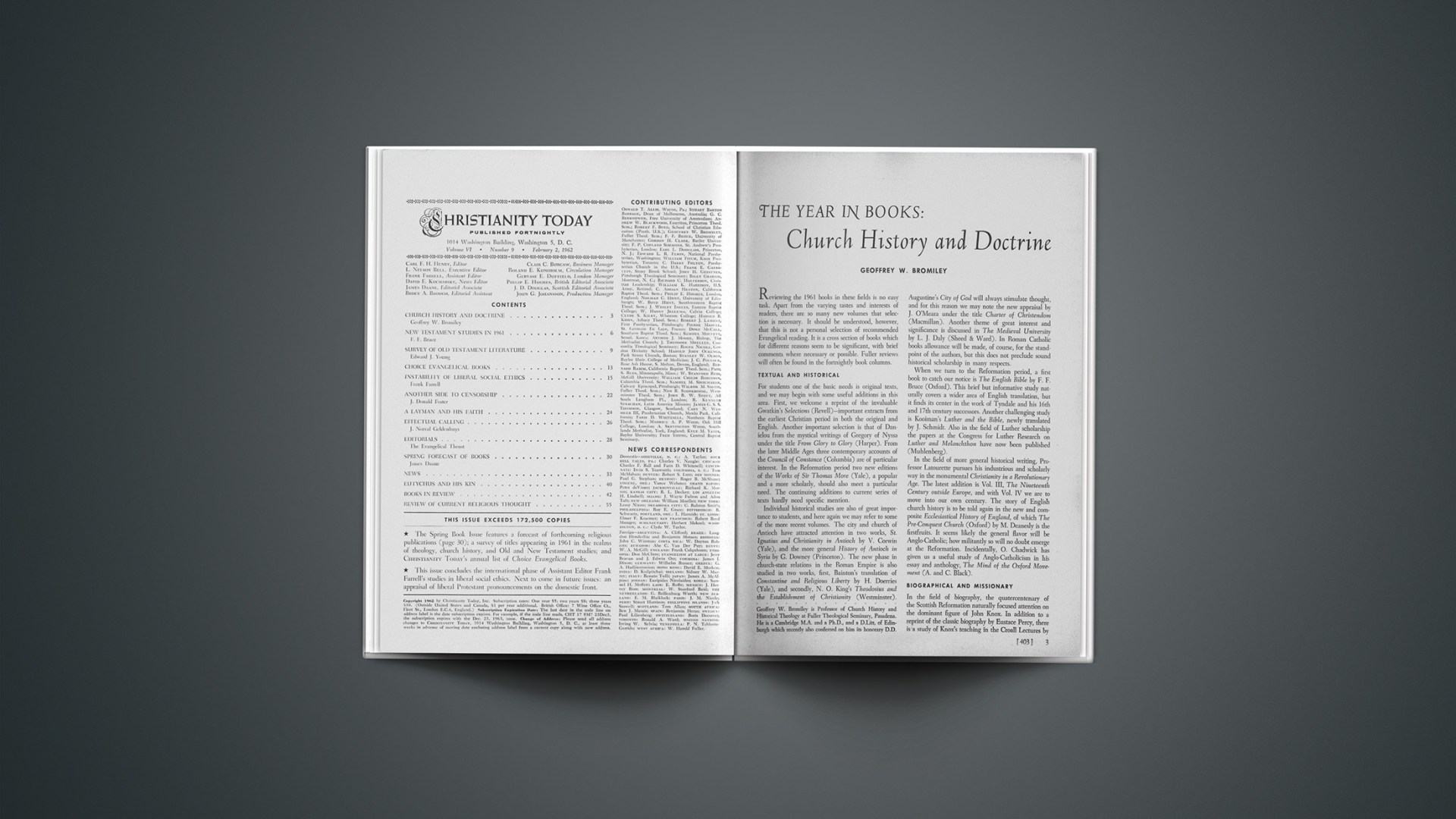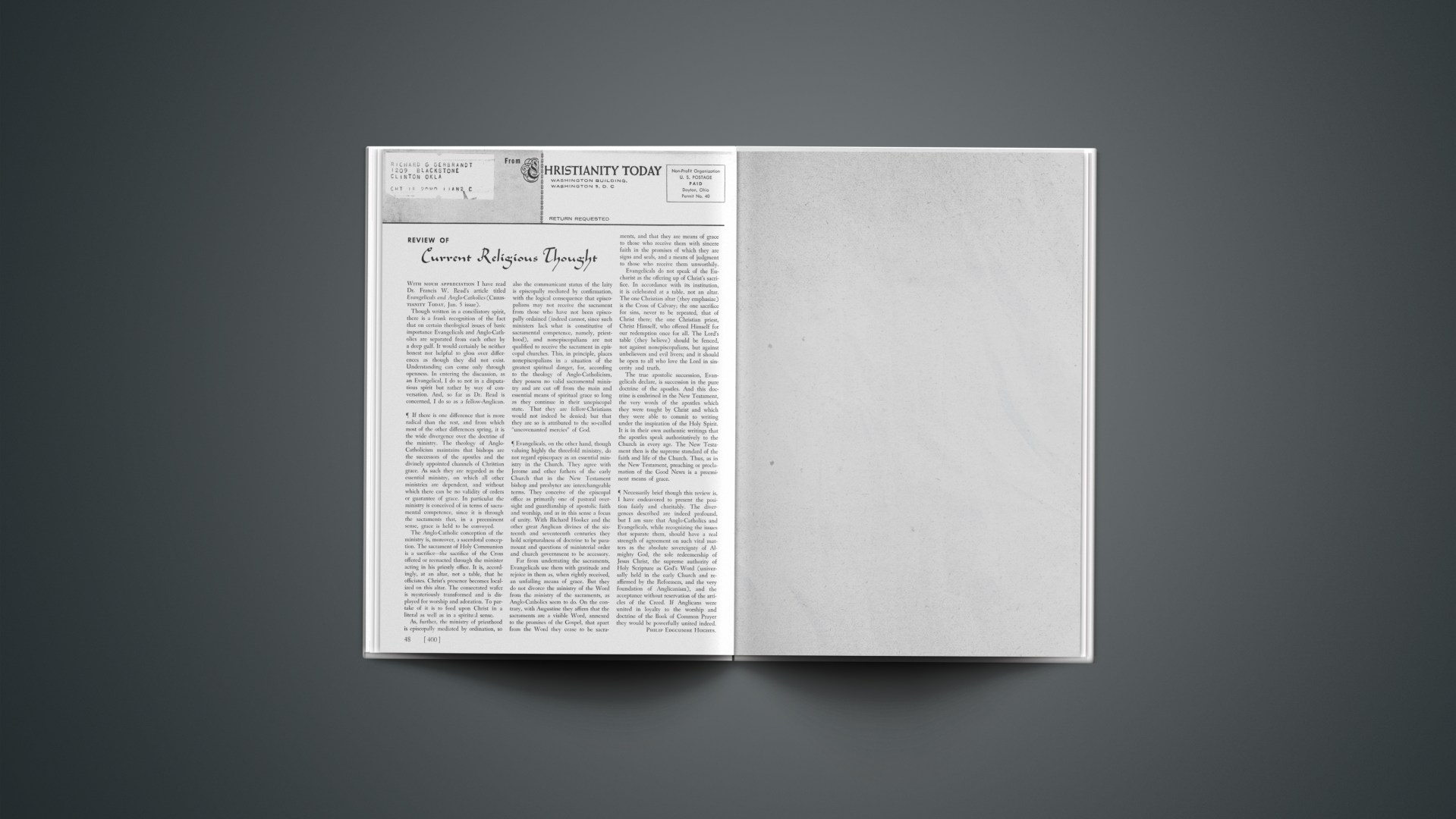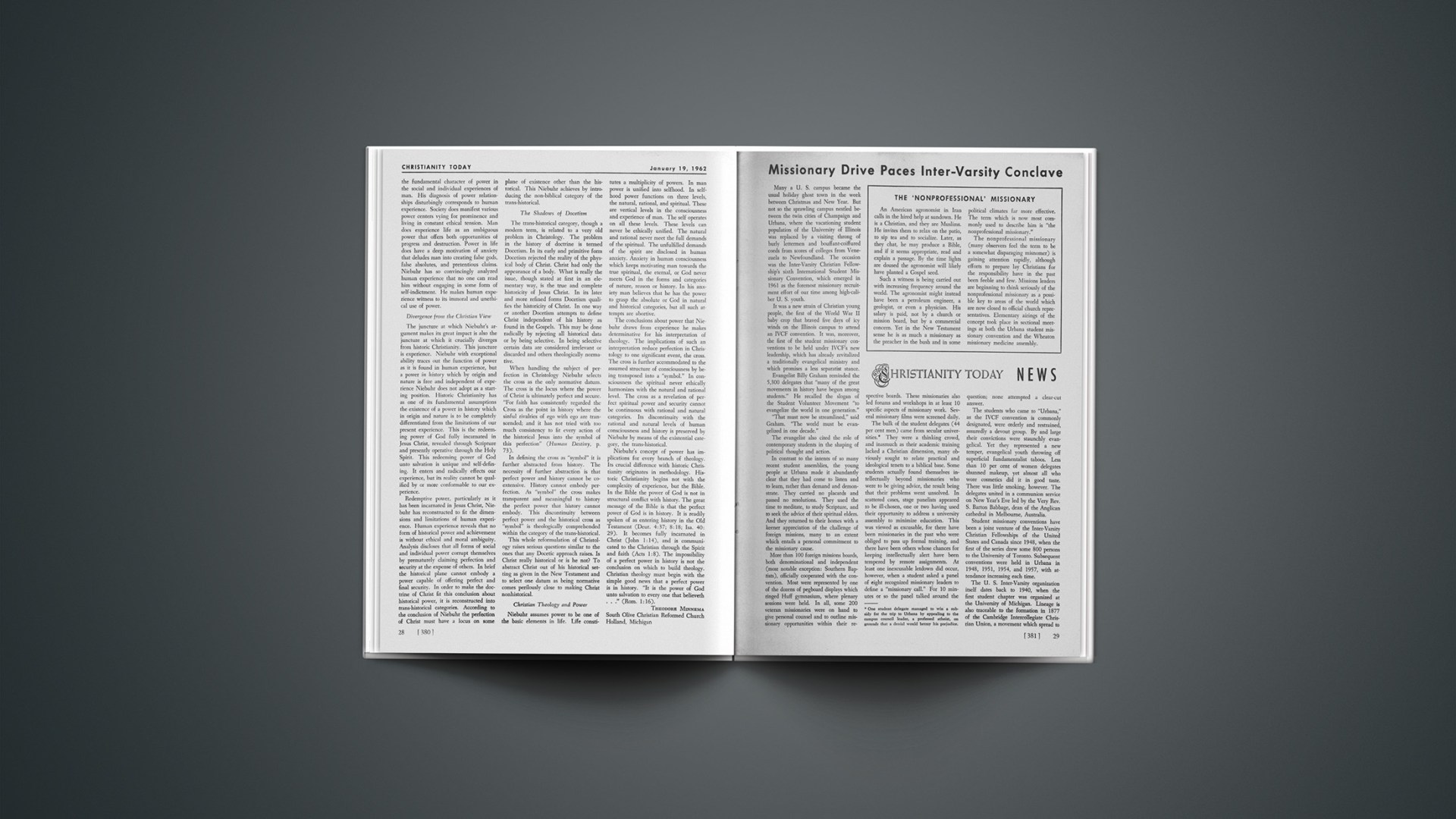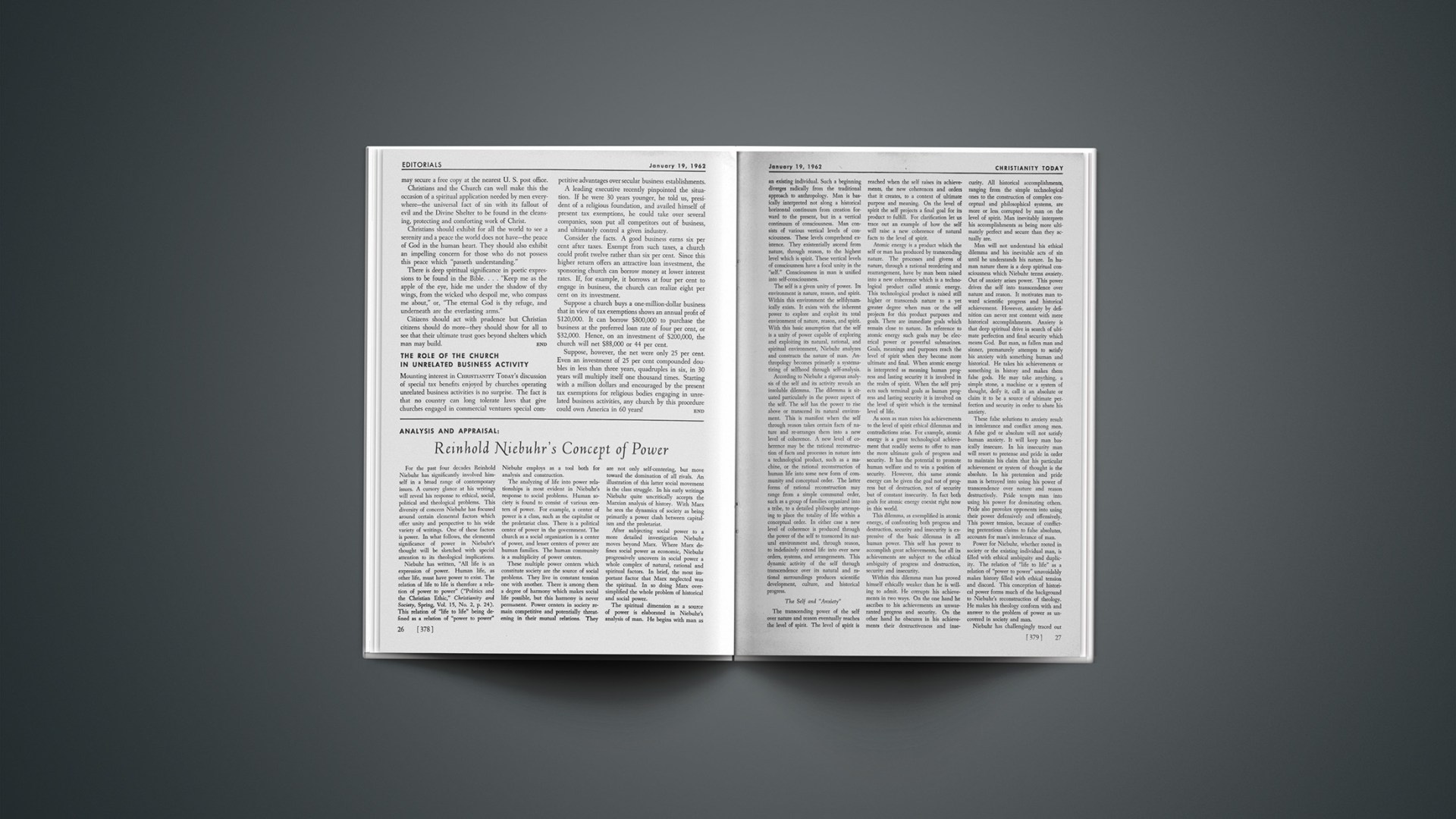Peace and War (Part III)
Debate among American Protestant churchmen in 1940–41 on the question of U.S. intervention in the war was intense and at times bitter. But Pearl Harbor cut it short. Pacifism then receded, though not completely. Yet it was not replaced by the fervor of a holy crusade.
The stopping of Hitler seemed to many a more clear-cut and vindicable war motive than the Kaiser’s defeat. But whereas The Christian Century responded to America’s entry into World War I with enthusiastic support of what it felt to be a just and virtually holy war, it reacted to the second intervention as “an unnecessary necessity.” It would now stand dubiously with its country though it had opposed the course by which the administration “was taking us into a war which was not our war.” The nation had chosen the way of “doubtful morality.” Even at the moment of Japan’s treacherous attack, the United States was “engaged in an undeclared war” (Dec. 17, 1941, pp. 1565 f.).
Before Pearl Harbor, Charles Clayton Morrison had pronounced himself an agnostic on the question of absolute pacifism (Dec. 12, 1941, p. 1536), and with war’s arrival the Century was quick to point out that both pacifist and nonpacifist were “involved in guilt” because national solidarity prevented the escape of cither from the war. The soldier kills and the pacifist leaves the treasures and destiny of the community to be preserved by others. When war comes, the citizen faces three questions,
“and the question of righteousness is not among them: Do I want my country to live? Do I want its independence preserved? Am I willing to do the monstrous evil which war requires in order to maintain the power upon which the independence of my country now depends?”
These questions “define the issue between the pacifist and the soldier” (Dec. 31, 1941, p. 1632). To claim either that the war is righteous or evil, moral or immoral, is wrong—war is “a-moral” (Jan. 7, 1942, p. 6). Men like John Bennett and John Mackay who claim it to be God’s will to seek the defeat of Nazism are in effect adopting “the tribalistic conception of God.” Japan, Britain, Germany and America were all judged guilty by God (Jan. 14, 1942, p. 39).
The title of the following week’s editorial proclaimed a distinctive Century doctrine: “War Is Not Sin; It Is Hell.” “Hell is not sin; it is the punishment for sin. So war is not sin, but the wages of sin.” War was too vast and impersonal to be called sin. “Hell is that realm or condition or situation—call it what you will—temporary or enduring—here or hereafter—where good and evil have lost their distinction, where evil is good and good is evil” (Jan. 21, pp. 72–74).
A Christian soldier in battle could well give thanks that this view of war was exaggerated. And too, the view of hell was deficient. A Federal Council of Churches commission report would reject the Century thesis that war is hell (Jan. 24, 1945, p. 103).
But more immediately, the journal faced the trenchant criticism of Reinhold Niebuhr, in which Morrison saw an “unmistakable tone of contempt” (Dec. 23, 1942, p. 1590). Niebuhr characterized the Century view as “bad politics, bad religion and bad morals.” He found untenable the absolute distinction between peace and war—the one being governed by freedom and the other by necessity—for all history “is a curious mixture” of both. As to the declared “absolute impossibility of discriminating between the comparative justice of embattled causes,” this was an “obvious falsehood” which sees “no significant distinctions in history between enslavers and slaves” and results in “immoral nationalism.” (ibid. pp. 1589 f.).
In reply, Morrison contended the purity of the Christian faith was at stake in the distinction he drew between “fighting repentantly” and “fighting righteously.” The latter was said to involve “tribal theism” (Dec. 30, p. 1622). After all, one reason for the fighting was the maintenance of the white race’s “predominant position throughout the world,” Asia included (July 1, 1942, p. 830). The fall of Singapore to the Japanese was seen hopefully as the death of “white imperialism” (Feb. 25, 1942, pp. 238 f.).
The Century’s just war of 1917 had given way to its unblessed war of 1941. Stanley High saw the Century as chiefly responsible for the failure of the Church’s representative assemblies to endorse the war as being for a just cause (Sept. 23, 1942, p. 1143). Federal Council commitment to support of the war was subsequently attacked by the Century, which indicated such blessing to be betrayal of the church and its Lord (Dec. 23, 1942, pp. 1583–1585; June 17, 1942, pp. 773–775). The Century called upon Churchill and Roosevelt for a statement of war aims and declared inadequate the goal of disposing of the dictators (Jan. 8, 1941, pp. 47–49; Dec. 18, 1940, pp. 1574 f.). No socialist goals had been proclaimed, and, after all, Hitler had initiated a social revolution.
Then too, there was Stalin, who was sustaining a social revolution. The September 29, 1943, issue of the Century featured on its cover this editorial title: “LET STALIN TAKE GERMANY!” It had earlier conjectured that Stalin would “make terms with Germany before the Allies bring Germany to her knees’ (Sept. 1, 1943, p. 983). German thirst for communism was assumed:
“The surrender of Germany to the Western allies in preference to Russia is an incredible eventuality. The postwar intentions of the Western allies make it certain that Germany would infinitely prefer to place her fate in Russian hands.… Stalin can offer her a peace which the German people, defeated, will be only too glad to accept. Surrender to Stalin would insure not only the overthrow of Hitler, but, in all probability, a communist revolution.…
“[Stalin] could … offer Germany a place in the U.S.S.R. on the basis on which the republics of that union are now federated.… Let Stalin gain our postwar aims for us!… Let Stalin take charge of Germany’s future. He can do it without policing her … (Sept. 29, 1943, pp. 1095 f.).
The Century had trusted in Stalin’s pledge not to seek communization of eastern Europe—“Why should he?” (Mar. 10, 1943, p. 289). But a year later this question didn’t seem to matter so much. Stalin’s “latest revision of the Russian constitution” was thought to transform the Soviet Union “from a monolithic unit into a federation of sixteen autonomous republics.” Here Stalin held out to “the entire continent” of Europe a “concrete basis for federation,” which, if agreed to by the European nations, would “bring into being a true federation without military, economic or political rivalries!”
“Stalin is playing for great stakes. They are by no means all selfish stakes. Selfish considerations undoubtedly enter in, but these are lost in contemplation of the great ends which may be achieved. The boldness and concreteness of his proposal, as embodied in this reorganization of the U.S.S.R., reduces the piddling, niggling plans of the other Allies for dealing with the dire realities of postwar Europe to puny proportions.… Future peace in Europe depends upon the unification of Europe, and here is a way to unification that is wholly removed from the realm of abstract speculation. It leaves room—some room, even though not too much—for democracy in the system which it sets up” (Feb. 16, 1944, pp. 198 f.).
Liberal optimism indeed—gone collectivist! When British troops intervened against the leftist partisans in Greece to prevent establishment of, in Churchill’s words, a “communist dictatorship,” the journal attacked the premier for entering on the side of “social and political reaction” (Dec. 20, 1944, pp. 1470 f.).
In 1955 the Century would indicate that had Churchill possessed more power at Cairo and Yalta and not been ejected from Potsdam, “the world would be closer to peace today” (Apr. 20, p. 469). But in 1945 the journal voiced lack of confidence in him as a peacemaker (Jan. 31, pp. 134 f.) and later that year approved his defeat (Aug. 8, p. 903). As for Yalta:
“… it is better to have the strong mind of Stalin reflected in the decisions for liquidating the European war than to have more of the fumbling and botching that has gone on in North Africa, Italy, Greece and Belgium. Stalin at least knows exactly what he wants to do in Germany, Poland, Yugoslavia …” (Feb. 28, 1945, p. 263).
But in 1953 Yalta would be dismissed as a “booby trap” (Jan. 14, p. 41).
The end of the war in Europe found the Century keenly interested in the Nuremberg war trials, for Justice Robert H. Jackson, chief counsel for the U. S., announced he would prosecute the Axis leaders on the basis of the Kellogg-Briand Pact.
In “War Is Still Outlawed!” Morrison declared, “… the civilized conscience demands that these men be tried for the total massive crime with which they are charged.” He took the occasion to reaffirm his faith in outlawry of war. Confessing a “too ardent” optimism over the 1928 Pact’s immediate consequences, he yet maintained, “… of its long-range effects I have had no doubt, even in these years of international madness.… [War’s] outlawry will some day be taken as the foundation of a world order of law, justice and peace” (June 27, 1945, pp. 755–758). “The official and legal theory on which this war has been fought by the Allies is that Germany was the aggressor—she violated the Kellogg pact. She now suffers its penalty in the utter defeat which the nations in collective self-defense have imposed upon her.” Prosecution on the basis of the Pact “is legally sound, despite the lack of precedent which [Jackson] frankly acknowledges” (Aug. 15, 1945, p. 926).
But this was beginning to sound like the Century’s just war of 1917 rather than the unblessed, a-moral hell of 1941, where the question of righteousness had no relevance.
The redeeming factor seemed to lie in recourse to the Pact. “… These trials will lift international law to a status of authority over nations which has never before been recognized” (ibid., p. 927).
After the verdicts had been handed down, a Century editorial, “Majestic Justice,” declared the “nazi war criminals” were “given a fair trial.” Though they could have been exiled, “the stomach of mankind could not tolerate their continued presence in a civilized world.” “… The soul of civilization, of humanity itself, cried out for a chance to render its judgment upon the men … (Oct. 16, 1946, p. 1238).
This was strong language for a periodical which had opposed capital punishment through the years and later would not make an exception even in Adolf Eichmann’s case (Dec. 27, 1961, p. 1549). But in 1949 the Century indicated “legal and moral misgivings” about the trials, noting the absence from the bench of justices from non-belligerent states (July 13, p. 838).
After Hiroshima and Nagasaki, the Century spoke again of the unblessed war in condemning the “wantonness” of “America’s Atomic Atrocity” (Aug. 29, 1945, pp. 974–976).
The post-war Century thrust was toward world government, including the Communists, through the United Nations. The journal advocated speaking softly to the Russians and working for disarmament.
Late in 1942 the Century had looked toward the postwar world and seen three U.S. alternatives: (1) a world organization, which it favored, involving curtailment of U.S. sovereignty; (2) isolation leading to world anarchy; and (3) the Henry W. Luce “vision of a world gripped and ruled by America’s naked might,” which “is doomed to end in another world conflict and would lead to the destruction of the United States by the exhaustion of its resources” (Dec. 2, pp. 1478 f.).
The subsequent manifestation of the schism between Russia and the West revealed dangerous weaknesses in the U. N. and its Security council. But the Century fought against any reliance upon a balance of power. When Churchill, in his “Iron Curtain” speech at Fulton, Missouri, chose to declare publicly some of the realities of the period, the journal denounced “talking tough” to Russia (Mar. 20, 1946, pp. 358–360). Some doubt was implied as to there being a “world threat … of Russian expansion” (ibid., pp. 358–360).
As the Century later took note of Russian violation of the “political integrity of more than a dozen countries during and since the war,” it attributed this to nationalism and denied that Communist ideology had caused such expansionism (Nov. 6, 1946, p. 1333).
In 1960 the Century would affirm that President Truman’s “policy of military encirclement” “did save Greece” (June 29, p. 766). But in 1947 it harshly attacked what came to be known as the Truman doctrine, “the bolstering with American arms and personnel the military strength of Greece and Turkey against Russia.” “Mr. Truman has taken the road that leads to war.” His action was said to reflect “the militaristic ideology that has become ascendant in his administration,” which wants “to take the broken fragments” of the British empire “under the wing of the United States” (Mar. 26, pp. 389–391).
The year before, the Century had criticized the U.N. for not having advanced beyond the League of Nations on the matter of member nations giving up their absolute sovereignty. The journal found here the cause of the League’s failure and urged the U.N. to recognize the outlawry of war “as the fundamental law of the world and the cornerstone of its organization” (Oct. 16, p. 1240). Now in response to the Truman doctrine, the Century idealistically issued a manifesto for world government:
“Henceforth the item of highest priority in the foreign policy of the United States must be the preservation and extension of the United Nations.…
“The Truman policy should be rejected in full recognition of the fact that the United States has surrendered to the United Nations those elements of sovereignty which are involved in the present issue. Congress has forsworn nationalistic intervention” (Apr. 16, 1947, p. 487).
Congress should thus allow the U.N. the final decision for or against the Truman doctrine so as to act “on the new principle that ultimate sovereignty now rests in the world community, not in the nation.” For effective U.N. action, it was recommended the charter be changed to disallow a veto by a nation which is a major party in the case in dispute—even though it was recognized this would probably mean Soviet withdrawal from the U.N. “… Military assistance of the kind required would be forthcoming, but it would be given by the United Nations, not by a single nation. Freed from the Russian veto, that body would proceed to set up the world police force which is authorized in its Charter.” Such a course would provide “the beginnings of a real world government.” The U.N. “cannot hope to survive on any lesser terms than as an actual world government” (ibid., pp. 487 f.).
The Century had opposed the League because of its power to apply sanctions. Now the need of force, though international and not national, was granted. Thus had liberal optimism been tempered by the relentless pressure of world realities. Later, there would be uncertainty that “the idea of a U.N. armed policing of world peace can be made to work” (Apr. 25, 1951, p. 519).
The Century saw world government as the only alternative to doom and lifted the banner for church action: “We believe that the crisis of humanity demands that the churches … shall once again declare their faith in a world government as the ground and guarantor of peace, and shall throw themselves with all the resources they can command into the crusade to set up such a government” (Jan. 14, 1948, p. 39). Russia was to be invited to participate (Feb. 11, 1948, pp. 166 f.).
The Century noted the churches’ increasing caution on the subject of world government (Jan. 28, 1948, p. 104) as well as the “chilly silence” of the U. S. government. Such citizens as Reinhold Niebuhr, John Foster Dulles, and Eleanor Roosevelt believed that “the cause is hopeless and to espouse it is to be guilty of naiveté” (Feb. 25, 1948, p. 232). But with regard to the Century, liberal optimism had come through the wars breathing heavily and somewhat staggered—it was not dead.
Prior to each U. S. war of the Century’s lifetime, the journal has fought preparedness measures. Korea did not break the pattern:
“President Truman’s denunciation of Russia by name, coupled with his demand for conscription and his pledge of military aid to Western Europe, constituted a direct threat of war.…
“Conscription, either through Selective Service or [Universal Military Training], must be defeated. The war budget must be cut, not increased. And the one hope the nation has that this can be done is in the churches.… A deluge of letters from church members demanding the defeat of war measures is now our only hope of anything like a Christian foreign policy or peace” (Apr. 14, 1948, p. 324).
Two months later in the last of a series of six editorials urging world government, the churches were told they desperately needed a “great moral crusade” to show members and outsiders that the churches were not “fiddling about with petty concerns.” This could not be found in opposing the spread of communism, for this was too negative a cause “to release great moral energies” and would involve the churches with too many “reactionary allies.” The great cause then, was to be federal world government (May 19, pp. 469–471).
The Century fought the creation of the North Atlantic Treaty organization from the beginning, as likely to hasten war with Russia (Dec. 8, 1948, p. 1326), and predicted the military services would control U. S. foreign policy for NATO’s duration (Feb. 23, 1949, p. 230). The organization was seen bypassing the U.N. and constituting a return to balance of power politics, fatal to the conception of world organization. It carries “the seed of disastrous breakdown within it” (Mar. 30, 1949, p. 393).
Tragedy In The Far East
The latter judgment came on the heels of communism’s greatest postwar victory, the fall of China. In 1945 the Century had termed “unnecessary” U. S. unilateral intervention on behalf of Chiang, as advocated by Life magazine and its publisher Henry Luce and had thus begun its habit of urging referral of all such problems to the U.N. (Dec. 12, pp. 1342 f.). And less than two years before Communist take-over of China, the Century had declared that even if Chiang should drop out of the picture, China would be far more likely to return to the anarchy of the warlord period than become a Communist state (Jan. 21, 1948, p. 73). When Chiang did fall, no regrets were expressed (Feb. 2, 1949, pp. 134 f.). But the journal printed as an article a letter from T. C. Chao, dean of the School of Religion at Yenching University and a president of the World Council of Churches, in which he professed to rejoice in the success of the Communists, who “admirably” provided a needed shake-up of Christianity in China (Mar. 2, 1949, pp. 265–267). The Century lated described the conquest as “a people’s uprising” and a “popular repudiation” (Dec. 28, 1949, p. 1534).
In the field of atomic energy, the Century opposed U.S. development of the hydrogen bomb though Russia had achieved an atomic explosion. It now called upon the churches to begin yet another crusade—“the elimination of war” (Jan. 18, 1950, pp. 70 f.). (But it was also strongly critical of pacifism [Mar. 15, 1950, pp. 327 f.; see also Apr. 4, 1951, p. 423].)
Then came the Korean War. After some initial uncertainty as to the wisdom of U.S. intervention (July 12, 1950, p. 838), the Century indicated such naked aggression should be stopped, although U.S. bungling had led to the crisis (Aug. 30, p. 1014). “We must take the determination of our foreign policy out of the hands of the Pentagon … and place it in the hands of the United Nations” (July 26, p. 887). Universalization of U.N. membership was recommended before Red China had entered the war (Aug. 9, p. 942). Effort through the war to cement the U.N. into a cooperative body “is at least as important as checking Communist aggression” (Apr. 11, 1951, p. 451), and General Douglas MacArthur was seen to be blocking this. His dismissal was approved (Apr. 25, 1951, pp. 519 f.). Even after Communist China had gone to war against the U.N. forces, the Century seemed unsure as to the advisability of admitting her as a U.N. member (May 16, 1951, pp. 606 f.). And there were now misgivings as to effective U.N. use of military force, opposition being given Dean Acheson’s effort to put teeth in the charter’s military clause (Aug. 1, 1951, pp. 886 f.).
It was confessed that world government lay “far in the future” (Dec 10, 1952, p. 1431). No longer were the churches being called on to crusade for it. With disclosure of the cobalt bomb, the Century’s rallying cry to the churches was that they “take the lead in stirring up a demand from the peoples for atomic disarmament.” The U.N. was called on to establish a world authority to prohibit future production of nuclear bombs (Apr. 21, 1954, p. 487). The journal admitted that no inspection system would be foolproof. Thus disarmament had to be thrust into “the inner consciousness of every individual on earth.” It was a long road. Niebuhr confessed the “terrible position” the U.S. would be in had the President “followed the advice of some of us” and not proceeded with development of the hydrogen bomb (Aug. 18, 1954, p. 972). The Century resignedly recognized that widespread U.S. commitments probably meant continuation of conscription was necessary, and it opposed unilateral disarmament, which would leave the U.S. defenseless (Dec. 15, 1954, p. 1510), After “communist victory in Indo-China,” the Century called for “universalizing” of the U.N. membership which meant admission of Red China (Aug. 4, 1954, pp. 917–919), and later spoke slightingly of the Southeast Asia Treaty organization (Mar. 30, 1955, p. 390). Churchill, Truman, and Marshall had all come under Century attack for “talking tough” to the Russians. It was now Dulles’ turn, and he was criticized also for extending military alliances (June 1, 1955, p. 648). The Century suggested his ouster (Jan. 23, 1957, p. 100). This was shortly after the rape of Hungary, which showed the impossibility of “any true church’s adjustment to any part of criminal communism” (Nov. 14, 1956, p. 1318). And shortly thereafter the American churches were called on to “take up the appeal” for disarmament (Feb. 6, 1957, p. 159). Liberal optimism seemed sturdy enough in advocating the signing with Khrushchev of another pact to outlaw war (Jan. 1, 1958, p. 3), but it was later drooping with the prediction of the “likelihood” of nuclear war (Mar. 5, 1958, p. 267).
The Century called the 1958 U.S. intervention in Lebanon a disaster: “We shall long rue the day it happened” (July 30, p. 867). It advocated uniting of the Arab states, the resulting state to pursue a neutral course in the cold war (ibid. pp. 868 f.). The journal had previously indicated its approval of “neutralized zones of nations” in Europe and Asia (June 1, 1955, p. 648). It indicated that U.S. recognition and U.N. admission of Red China would be profitable (Nov. 5, 1958, p. 1261; see Dec. 3, 1958, pp. 1387 f.). As to Castro’s Cuba, the Century favored “persistent nonintervention in the face of provocation plus a positive program of mutual aid” and opposed those who favored using the economic weapon (Mar. 16, 1960, p. 308). Such liberality prevailed despite the firing squads—so unamenable to Century ethics, but it pointed strictly leftward. Less than a month later, the journal advocated a boycott on South African gold “to bankrupt the racist regime” unless the policy of apartheid were changed. No Communist country but rather South Africa was branded as “the country which currently threatens world peace more seriously than any other” (Apr. 6, p. 405).
In striking reversal of a previous stand, the Century advocated unilateral nuclear disarmament on the part of the United States: “Fifteen years of suspension over the fires of nuclear hell is long enough.” But still the liberal optimism: Such an act “would very likely result in the lessening of the threat from the communist side” and if they tried to enslave us we could “organize nonviolent resistance” and could conquer them in the end “by moral force” (Aug. 3, 1960, pp. 891 f.).
On the Berlin crisis, the Century’s answer was the durable and resilient “take it to the U.N.” Berlin could be made “an international city” under the U.N. (Aug. 2, 1961, p. 925).
Philosopher Karl Jaspers looks upon the U.N. as a basic untruth, its power depending not on the United Nations but on the policies of the sovereign powers alone. And he insists that world government could be set up only by conquest and sustained by despotism. For the Century, on the other hand, if world government is now but the distant hope, no issue in world affairs is currently as important as “keeping” the U.N. “free and strong.” Christians are urged to support it (Oct. 18, 1961, pp. 1227 f.). Truth is, the Century is facing a world of vanishing alternatives. For maintenance of peace it lacks confidence in balance of power, balance of terror, concert of free nations, a strong U.S. (ibid., p. 1228). Never a journal to refer the ultimate hopes of its readers to the biblical hope and the final solution to war—the return of the Prince of Peace in the power and glory of the Second Advent—the Century more often spoke of the greatness of the human spirit, neglectful of the biblical doctrine of man despite the lessons of recent and contemporary history. Seeing the need of the liberal wing of Protestantism for an enlivening cause, it baptized secular causes lacking biblical mandates, such as world government and disarmament. Its pacifism owns no biblical base as that of the historic “peace churches” but shifts pragmatically with the political currents of the day. In calling the churches to crusades, there was failure to give like attention to the crusade implicit in the Master’s Great Commission, embodied in missions and evangelism, toward making more of the earth’s peoples responsive to his unifying lordship. For world unity, the dominant continuing emphasis was not on the hymnist’s goal: “Ye nations of mankind, in this your concord find: May Jesus Christ be praised!”
Were not social ethics of such crucial importance to the theological liberal, contradictions from generation to generation and year to year could perhaps be passed off somewhat lightly. But the Gospel itself is at stake.
The almost mystical faith in the U.N. was somewhat disturbed by Goa and by Adlai Stevenson’s talk of the U.N.’s possible death. Said the Century, “If the U.N. cannot survive, can we?” (Jan. 3, 1962, pp. 5 f.). If men did survive, it seemed certain that liberal optimism would survive too, after yet another terrifying confrontation with reality.
Desperately needed was the biblical elevation of resurrection over survival, a trumpeting of the revolutionary cure for mankind’s ills: regeneration by the Holy Spirit, conversion to the King of kings—in short, a renaissance of the soul.

